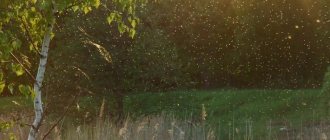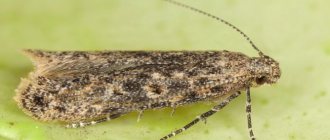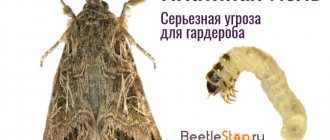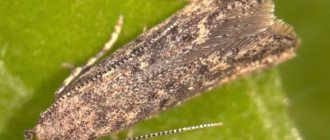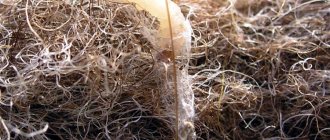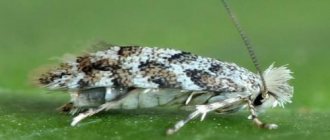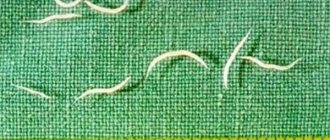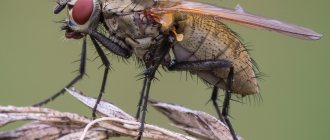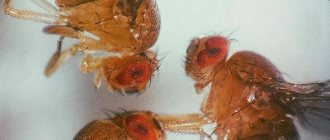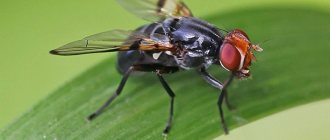- home
- Pest control
- Removing clothes moths in an apartment
- Types of moths
A moth is an insect that absorbs the substance of the stratum corneum - keratin. Such organisms are also called keratophages. But despite this, we often notice these insects crawling in the closet or flying around the house in search of woolen items. Why are they so attracted to wool? The answer is simple: at the molecular level, wool and fur contain the moth's favorite food product - keratin. Thanks to the unique environment of the stomach, which contains a lot of acid, moths easily digest keratin.
What you need to know about moths
The moth can be characterized by the following characteristics: it looks like a small butterfly of brownish-yellow, pale gray or white with a lot of silvery pollen on the wings. This insect goes through the following stages of development: the eggs hatch into larvae, then they become butterflies, and the adults, in turn, lay eggs. Moths themselves are practically harmless. You should be wary of larvae that hatch from eggs laid by butterflies in the fibers of things.
It is important to note that butterflies experience discomfort from sunlight, so they mainly live in dark places that are difficult for sunlight to penetrate - for example, in closets, closets and chests of drawers. The offspring hatched from the eggs, like butterflies, prefer to be in the dark, where it is almost impossible to detect the larvae. It should be noted that in the cozy conditions of city houses, moths are able to lay eggs all year round!
Harm
How are clothes moths useful? If we talk about an enclosed space where this pest spreads, then it will not be useful. Moths are found not only in unusable things, they are also capable of destroying new materials. But the insect is a kind of indicator that warns that the closet needs to be reviewed and unnecessary items removed from there. In nature, moths bring considerable benefits as food for birds. Also of particular benefit is the wax moth larva, the product of which is used in the treatment of tuberculosis.
Lifespan of a moth
This is a rather important question, considering that insects actively eat clothing and furniture.
Before the onset of puberty, the individual goes through two stages of development: egg and larva. At an air temperature of 20 degrees Celsius, the laid egg takes two weeks to develop. The larval development period varies from three to ten months. At this time, the larvae form a cocoon around themselves from the nutrient material, in which they develop further.
After acquiring wings, the individual does not live very long - only 2-4 weeks. This period varies depending on the type of parasite. During these weeks, individuals are not particularly mobile and fly mainly in the dark, since the wings are poorly developed, which makes the insects very vulnerable.
If you add up the three periods of time during which the life of a moth occurs, you get a very impressive period of time during which the parasites do not waste time destroying interior items and wardrobe items.
Why and how to start
The answer to the question of how moths start in things is simple: more often the larvae of parasites enter an apartment with new clothes, textiles, and furniture. If, after purchasing a new item, flying pests appear in the house, you should immediately inspect the purchase to identify larvae.
Contrary to popular belief, moths cannot move between apartments. This happens only in rare cases. This is due to the fact that female pests practically cannot fly, despite the presence of formed wings. However, they are capable of making short flights in search of suitable shelter.
What types of moths are there?
The most common types found in the home are:
Fur moth
The fur moth is an individual that has shiny dark yellow wings, with dark specks on the wings. The lower layer of the wings differs in color from the outer ones: they are light gray. The wingspan ranges from fourteen to fifteen millimeters. The fur moth prefers to feed on clothing made from natural materials. The hatching larvae look like worms, have white, almost transparent skin, through which the contents of their stomach can be seen, and eight very short abdominal legs. The larvae prefer to consume fur products.
Clothes moth
The clothes moth is larger in size than the fur moth; its wingspan is up to twenty-two millimeters. She also has two pairs of wings, which are purple at the very base, turning yellow towards the middle, with a small brown spot at the very top. The clothes moth larva is covered with a small white fluff and is similar in appearance to the coat moth larva. But, unlike their relatives, clothes moth larvae prefer to huddle in folds or inside woolen material, eating fairly large spaces of material that are invisible from the outside at first glance. The larvae are kept on clothing by a stationary cover.
Furniture moth
Furniture moth - a representative of this species has shiny silver-yellow wings, the head is dark yellow, and the base of the wings has a brown tint. This variety of keratophages has a significant difference from all other species and thanks to this it was declared a separate genus. This difference is the absence of oral tentacles. Furniture moth larvae destroy furniture in a unique way: first, the hair padding in the soft parts is eaten, then, closer to the pupation period, the larvae appear on the surface of the upholstery and begin to gnaw tunnels in the furniture cover. Pupation occurs on the lower surface of chairs, armchairs, sofas, and beds. In such places, a huge number of light cocoons accumulate. The period of development of larvae depends on the time of year: in winter it is five months, in summer – about two months. Pupation, as a rule, occurs towards the end of winter, that is, in February.
Agricultural pests
It is better to study the enemy thoroughly so as not to get confused if you suddenly have to meet him not only in the apartment, but also in the garden! It is quite common for entire colonies to attack agricultural crops, poisoning the lives of gardeners. Let's look at several main types of moths:
grain moth
The grain moth is a species of keratophagous silvery-white with a small bright brown pattern on the fore wings. They can also be recognized by their gray belly and wings, the span of which reaches up to fifteen millimeters. Pupation occurs primarily in spring and summer. Grain moths can most often be found in barns, warehouses, granaries and other places where grain crops are stored. An individual grain moth lays up to a hundred eggs directly on grains: one or two eggs are glued to each grain. The female combines several grains into a kind of lump with the help of a sticky liquid secreted, similar to a web, and eats them while inside this lump of web. To move, she has to drag the entire bundle behind her. This type of moth prefers to pupate in cracks in the floor and walls. In addition to grains, moths also eat dried fruits and various seeds.
Rye moth
Rye moth - this species has a wingspan of up to thirteen millimeters. The hind wings are dark yellow, with a brownish edging. The most common rye moth is found in central Russia. Individuals prefer to lay eggs towards the end of summer on wild cereals and on emerging winter crops. The larva eats the core of the stem and spends the whole winter in it. Pupation of rye moth larvae occurs closer to mid-summer.
Potato moth
This representative of parasites does not have the most attractive appearance: the wings are dirty gray in color and dotted with dark spots.
But in the larval stage, the individual is more pleasant to look at and has a light green (sometimes pinkish) color.
Having fledged, the individual acquires long mustaches and a body length of up to seven millimeters with folded wings. Life in this stage lasts only a few days.
The unprepossessing appearance appeared for a reason: it helps the pest remain unnoticed, even if you look at it, as they say, “point-blank.”
Females lay eggs on the surface of leaves on the underside. The larvae that hatch after some time develop very quickly.
As the name suggests, potato plants suffer from parasites. Individuals can remain alive until the temperature drops to 4 degrees. But individual individuals can climb into the tubers themselves and continue to exist there. Potato moths wait out serious cold weather, as a rule, in barns, which have enough seed potatoes for food. With the same potatoes, parasites re-enter the soil in the spring.
Cabbage moth
This parasite causes damage to cruciferous crops. Externally it differs from other types of moths: the body is oblong in shape and light green in color, covered with small hairs. You can easily confuse an insect with a straw if it folds its wings. The wings themselves are framed with fringe at the edges. The larvae have characteristic brown heads.
In terms of activity, cabbage pests are no different from the rest: they are inactive, fly poorly, and rarely move very far from the place where the cocoon is left. Parasites lead a solitary lifestyle and rarely gather in groups. On a leaf you can see one, maximum two individuals.
It is easy to detect and identify the eggs of the parasite: they are elongated and very small. The egg is up to 0.5 millimeters long and only 0.2 millimeters wide. The green color perfectly camouflages them on the foliage.
food moth
It parasitizes inside products whose storage conditions have been violated. These are mainly stocks of cereals and groceries in barns. Parasites also find food for themselves in the wild: nuts and crop fruits become prey. For this reason, food pests can often be seen in steppe and forest-steppe areas.
It is curious that this type of moth is not able to cause harm to furniture and clothing, since it can only consume cereals, flour, sugar, dried fruits and berries. Appearance: body length with folded wings is eight millimeters. The discreet color makes the parasite almost invisible.
The caterpillars have a pinkish or light yellow color and a smooth body. Ideal conditions for development are: temperature up to +25 degrees, humidity up to 50%. All life stages of an individual take no more than six weeks.
Deliverance is possible
How to get rid of moths? This process is quite labor-intensive and requires a significant time investment. Today, the following methods are used to control and influence the moth population in domestic conditions:
- carrying out regular dry cleaning;
- wet cleaning (washing) of premises and utensils for storing bulk products;
- freezing or heating food;
- fumigation and use of insecticides.
Each of these methods has its own advantages. In addition, the effectiveness of moth control is significantly influenced by the general condition and management of the household, periodic monitoring of the storage conditions of things and products that are the most “tasty” morsels for moths.
During cleaning, it is necessary to use complex methods that combine detection, localization and destruction of foci of infection. An important place in the complex of measures to prevent the appearance of these pests is occupied by the timely identification of places where they are concentrated - various cracks in the walls, under baseboards, under furniture, and so on. It is advisable to store bulk products in airtight containers. Wearable items that are not worn often should be dried regularly in bright sun.
The use of various chemical means of control - the same naphthalene or essential oils (lavender, cedar) - brings very good results. Special moth traps based on pheromones released by the male moth are also effective.
Chestnut moth
The foliage of maple and horse chestnut suffers from it. After spending the entire winter in the pupal state, adult insects emerge with the first warmth. Reproduction processes soon begin, which end with the appearance of new offspring within a couple of weeks. The young growth immediately clings to fresh foliage. This causes early leaf fall and tree death.
The destructive activity of the parasites can be seen by uneven orange spots on the leaves.
Oral organ
Fruit and house moths have features similar to butterflies. But there are also several distinctive parameters. Thus, the pests lack a proboscis, which butterflies use to extract nectar from vegetation. Since adult insects do not feed, their offspring are of interest. The larvae have a special structure of the oral apparatus. Due to the fact that they have powerful jaws, they easily bite through seeds, grains, vegetation and natural products. After the larvae develop into adults, they stop eating. This also provokes the rapid death of pests.
Difficulties in killing moths
The shelves of hardware stores are filled with insect repellents. However, modern pests can extremely quickly adapt to what they are trying to poison them with. This complicates the disinfestation procedure. You have to change medications regularly. And despite all this, final victory rarely comes.
In view of this, it is easier to take care of preventing the appearance of pests. Preventive measures will vary depending on the type of moth. Recommendations on the algorithm of actions in your situation should be obtained from specialists.
How to protect clothes
To protect your wardrobe from parasites, it is important to know what repels moths from clothes.
It is advisable to use folk remedies that do not harm things, human health, or animals.
You can save and protect clothes from moths using the following methods:
- Powders. The assortment of specialized stores includes powders based on substances that repel parasites. Such powders do not harm humans, and to obtain the desired effect, it is enough to place a bag of the substance in the closet.
- You can make powders that will help protect your wardrobe from pest invasions yourself. To do this, collect wormwood or lavender herbs, dry, grind, and place in the closet. Plant raw materials do not harm humans and do not damage the appearance of clothing.
Moth caterpillars prefer to feed on natural fur, which jeopardizes an expensive wardrobe item - fur coats. To avoid the appearance of pests, before putting the item away for summer storage, it is recommended to put the above products in its pockets.
It is important to remember that regular cleaning and washing of clothes will help prevent pests.
You also need to periodically ventilate your wardrobe, wardrobes, and apartment. This measure will help identify pests and reduce their numbers.

